Investigation into the Performance of TDR and FDR Techniques for Measuring the Water Content of Biochar-Amended Loess
Abstract
Highlights
- Biochar significantly affects the accuracy of TDR and FDR measurements.
- Water content measurement accuracy is related to biochar dosage and particle size.
- Dielectric mixing model can well describe the dielectric constant of BAS.
- Calibration equations are more accurate than empirical equations for BAS.
- It can promote the application of TDR and FDR in measuring the water content of BAS.
- The dielectric mixing model can provide a theoretical basis for calculating the dielectric constant of BAS.
- Calibration can improve the accuracy of water content measurement in biochar-amended soil.
Abstract
1. Introduction
2. Experimental Materials and Methods
2.1. Experimental Materials
2.2. Basic Principles of TDR, FDR, and NMR
2.2.1. Time Domain Reflectometry (TDR)
2.2.2. Frequency Domain Reflectometry (FDR)
2.2.3. Nuclear Magnetic Resonance (NMR)
2.3. Water Content Measurement of BAS
- (1)
- Water content measurement of BAS under room temperature. The experimental process is illustrated in Figure 2. First, all the BAS specimens were saturated using the vacuum saturation method. One EC-5 moisture sensor was then inserted into each of the specimens, which were subsequently placed in an oven with forced air circulation for drying to different moisture conditions. The temperature of the oven was controlled to a moderate value (i.e., 30 °C), preventing crack formation on the specimens due to fast temperature change. By doing so, the gravimetric water contents of the specimens were gradually adjusted to eight different target values: saturated state, 30%, 27%, 24%, 21%, 18%, 15%, and 12%. After that, the specimens were sealed with cling wrap and placed in a temperature-controlled chamber (approximately 20 °C) for 48 h to ensure uniform water and temperature distribution. Finally, the water contents of these specimens were measured by the EC-5 moisture sensor (Equation (3)), which was connected to a ZL-6 datalogger (METER Group, Pullman, WA, USA). The EC-5 was removed once the measurement was finished, and a CS640 sensor (Campbell Scientific, North Logan, UT, USA) was similarly inserted into the specimens for measurement using a TDR200 (Campbell Scientific, UT, USA) (Equation (1)), with data collected by a CR1000X datalogger (Campbell Scientific, UT, USA). After all measurements were completed, soil samples were taken from the specimens, and their actual gravimetric water contents were determined using the oven-dry method.
- (2)
- Water content measurement of BAS under subzero temperatures. The experimental process is illustrated in Figure 3. Similar to the room temperature measurement scenario, the specimens were first subject to vacuum saturation treatment. Then, an EC-5, a CS640, and a temperature sensor were inserted into the specimen. To prevent water loss, the specimens with inserted sensors were sealed using cling wrap. Subsequently, they were placed in water tight plastic bags and positioned in a thermostatic bath, which served to freeze the specimens to different subzero temperatures. During the freezing process, the temperature of the thermostatic bath was adjusted according to the following steps: 0, −1, −2, −3, −5, −7, −10, −12, −15, −17, −20, −15, −10, −7, −5, −3, −2, −1, −0.7, −0.5, −0.3, and 0 °C. The specimens were maintained at least 12 h under each controlled temperature for equilibration. Once the equilibrium condition was achieved, the unfrozen water content of the specimens was determined by the EC-5 and CS640 sensors, based on Equation (3) and Equation (2), respectively.
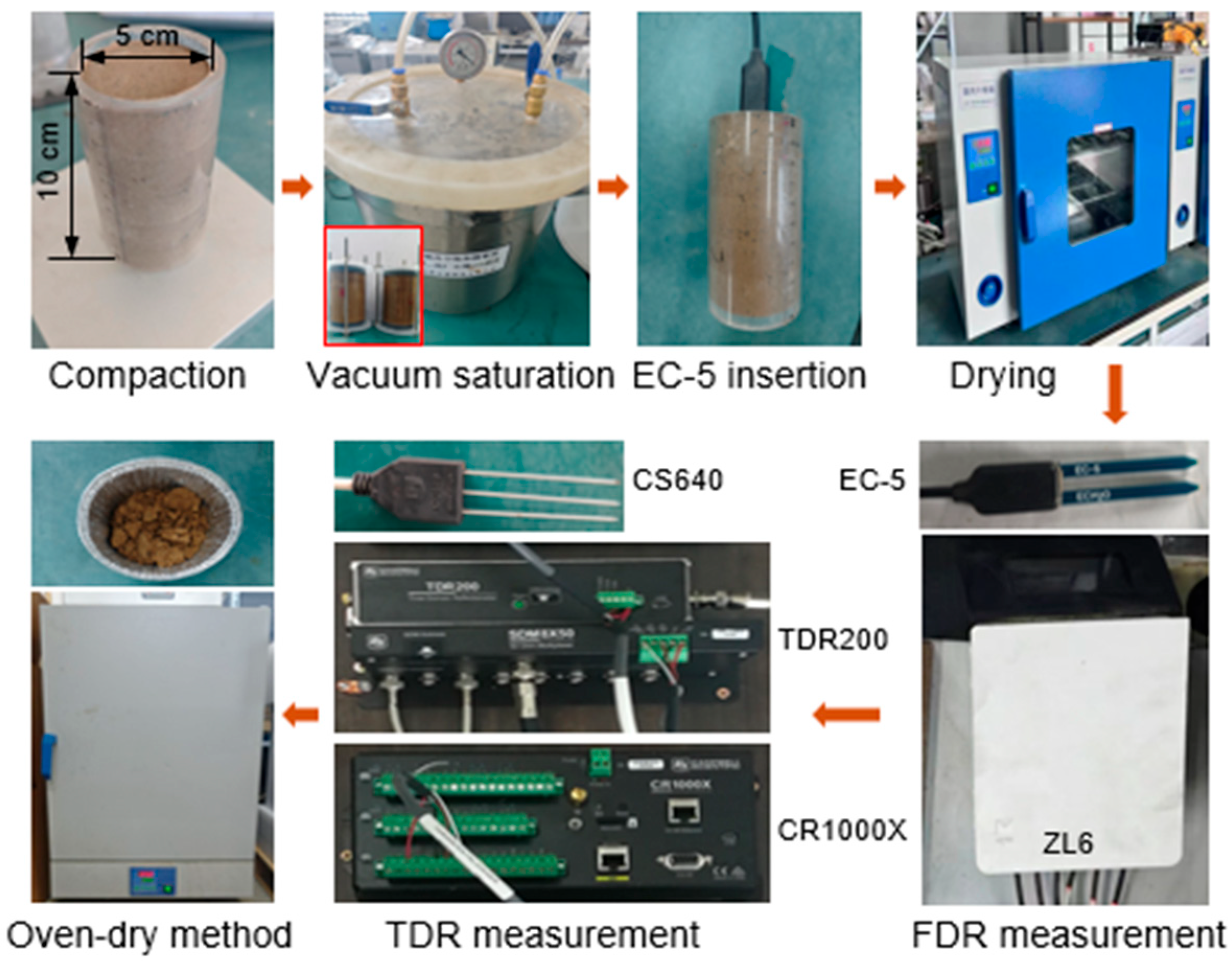

3. Experimental Results and Analysis
3.1. Effects of Biochar on BAS Pore Structure
3.2. Effects of Biochar on TDR Waveforms, BAS Electrical Conductivity, and Dielectric Constant
3.3. BAS Dielectric Constant Representation by a Dielectric Mixing Model
3.4. Comparison of Measured Water Contents with Actual Values
3.5. Calibration for BAS Water Content Measurement
4. Discussion
5. Summary
Author Contributions
Funding
Institutional Review Board Statement
Informed Consent Statement
Data Availability Statement
Conflicts of Interest
References
- Jin, C.; Lei, H.; Chen, J.; Xiao, Z.; Leghari, S.J.; Yuan, T.; Pan, H. Effect of soil aeration and root morphology on yield under aerated irrigation. Agronomy 2023, 13, 369. [Google Scholar] [CrossRef]
- Yu, C.; Mawodza, T.; Atkinson, B.S.; Atkinson, J.A.; Sturrock, C.J.; Whalley, R.; Hawkesford, M.J.; Cooper, H.; Zhang, X.; Zhou, H.; et al. The effects of soil compaction on wheat seedling root growth are specific to soil texture and soil moisture status. Rhizosphere 2024, 29, 100838. [Google Scholar] [CrossRef]
- Brocca, L.; Ciabatta, L.; Massari, C.; Camici, S.; Tarpanelli, A. Soil moisture for hydrological applications: Open questions and new opportunities. Water 2017, 9, 140. [Google Scholar] [CrossRef]
- Bwambale, E.; Abagale, F.K.; Anornu, G.K. Smart irrigation monitoring and control strategies for improving water use efficiency in precision agriculture: A review. Agric. Water Manag. 2022, 260, 107324. [Google Scholar] [CrossRef]
- Ingrao, C.; Strippoli, R.; Lagioia, G.; Huisingh, D. Water scarcity in agriculture: An overview of causes, impacts and approaches for reducing the risks. Heliyon 2023, 9, e18507. [Google Scholar] [CrossRef]
- Xiao, C.; Ji, Q.; Zhang, F.; Li, Y.; Fan, J.; Hou, X.; Yan, F.; Liu, X.; Gong, K. Effects of various soil water potential thresholds for drip irrigation on soil salinity, seed cotton yield and water productivity of cotton in northwest China. Agric. Water Manag. 2023, 279, 108172. [Google Scholar] [CrossRef]
- Xu, X.; Li, Q.; Lai, Y.; Pang, W.; Zhang, R. Effect of moisture content on mechanical and damage behavior of frozen loess under triaxial condition along with different confining pressures. Cold Reg. Sci. Technol. 2019, 157, 110–118. [Google Scholar] [CrossRef]
- Yan, F.; Meng, Y. Experimental Study on the Effect of Moisture Content on Shear Strength of Unsaturated Silty Clay. J. Eng. Sci. Technol. Rev. 2023, 16, 18–24. [Google Scholar] [CrossRef]
- Chen, H.; Gao, X.; Wang, Q. Research progress and prospect of frozen soil engineering disasters. Cold Reg. Sci. Technol. 2023, 212, 103901. [Google Scholar] [CrossRef]
- Jin, X.Y.; Jin, H.J.; Iwahana, G.; Marchenko, S.S.; Luo, D.L.; Li, X.Y.; Liang, S.H. Impacts of climate-induced permafrost degradation on vegetation: A review. Adv. Clim. Change Res. 2021, 12, 29–47. [Google Scholar] [CrossRef]
- Lu, J.; Wan, X.; Yan, Z.; Qiu, E.; Pirhadi, N.; Liu, J. Modeling thermal conductivity of soils during a freezing process. Heat Mass Transf. 2022, 58, 283–293. [Google Scholar] [CrossRef]
- Noborio, K. Measurement of soil water content and electrical conductivity by time domain reflectometry: A review. Comput. Electron. Agric. 2001, 31, 213–237. [Google Scholar] [CrossRef]
- Robinson, D.A.; Jones, S.B.; Wraith, J.M.; Or, D.; Friedman, S.P. A review of advances in dielectric and electrical conductivity measurement in soils using time domain reflectometry. Vadose Zone J. 2003, 2, 444–475. [Google Scholar] [CrossRef]
- Petrov, O.V.; Furó, I. NMR cryoporometry: Principles, applications and potential. Prog. Nucl. Magn. Reson. Spectrosc. 2009, 54, 97–122. [Google Scholar] [CrossRef]
- Wei, Y.M.; Han, R.; Liang, Q.M.; Yu, B.Y.; Yao, Y.F.; Xue, M.M.; Zhang, K.; Liu, L.J.; Peng, J.; Yang, P.; et al. An integrated assessment of INDCs under Shared Socioeconomic Pathways: An implementation of C 3 IAM. Nat. Hazards 2018, 92, 585–618. [Google Scholar] [CrossRef]
- Ahmad, N.; Youjin, L.; Žiković, S.; Belyaeva, Z. The effects of technological innovation on sustainable development and environmental degradation: Evidence from China. Technol. Soc. 2023, 72, 102184. [Google Scholar] [CrossRef]
- Henderson, K.; Loreau, M. A model of Sustainable Development Goals: Challenges and opportunities in promoting human well-being and environmental sustainability. Ecol. Model. 2023, 475, 110164. [Google Scholar] [CrossRef]
- Criscuoli, I.; Panzacchi, P.; Tognetti, R.; Petrillo, M.; Zanotelli, D.; Andreotti, C.; Loesch, M.; Raifer, B.; Tonon, G.; Ventura, M. Effects of woodchip biochar on temperature sensitivity of greenhouse gas emissions in amended soils within a mountain vineyard. Geoderma Reg. 2024, 38, e00847. [Google Scholar] [CrossRef]
- Lefebvre, D.; Fawzy, S.; Aquije, C.A.; Osman, A.I.; Draper, K.T.; Trabold, T.A. Biomass residue to carbon dioxide removal: Quantifying the global impact of biochar. Biochar 2023, 5, 65. [Google Scholar] [CrossRef]
- Campion, L.; Bekchanova, M.; Malina, R.; Kuppens, T. The costs and benefits of biochar production and use: A systematic review. J. Clean. Prod. 2023, 408, 137138. [Google Scholar] [CrossRef]
- Danesh, P.; Niaparast, P.; Ghorbannezhad, P.; Ali, I. Biochar production: Recent developments, applications, and challenges. Fuel 2023, 337, 126889. [Google Scholar] [CrossRef]
- Leng, L.; Xiong, Q.; Yang, L.; Li, H.; Zhou, Y.; Zhang, W.; Jiang, S.; Li, H.; Huang, H. An overview on engineering the surface area and porosity of biochar. Sci. Total Environ. 2021, 763, 144204. [Google Scholar] [CrossRef] [PubMed]
- Dong, H.; Leung, A.K.; Chen, R.; Lourenco, S.; Kamchoom, V. Changes in pore-size distribution and hydraulic conductivity of compacted soils by grass-derived hydrochar. J. Geotech. Geoenviron. Eng. 2023, 149, 04023079. [Google Scholar] [CrossRef]
- Rasa, K.; Heikkinen, J.; Hannula, M.; Arstila, K.; Kulju, S.; Hyväluoma, J. How and why does willow biochar increase a clay soil water retention capacity? Biomass Bioenergy 2018, 119, 346–353. [Google Scholar] [CrossRef]
- Wang, D.; Li, C.; Parikh, S.J.; Scow, K.M. Impact of biochar on water retention of two agricultural soils–A multi-scale analysis. Geoderma 2019, 340, 185–191. [Google Scholar] [CrossRef]
- Razzaghi, F.; Obour, P.B.; Arthur, E. Does biochar improve soil water retention? A systematic review and meta-analysis. Geoderma 2020, 361, 114055. [Google Scholar] [CrossRef]
- Zhang, Y.; Wang, J.; Feng, Y. The effects of biochar addition on soil physicochemical properties: A review. Catena 2021, 202, 105284. [Google Scholar] [CrossRef]
- Lu, Y.; Gu, K.; Shen, Z.; Tang, C.S.; Shi, B.; Zhou, Q. Biochar implications for the engineering properties of soils: A review. Sci. Total Environ. 2023, 888, 164185. [Google Scholar] [CrossRef]
- Daneshvar, S.; Mosaddeghi, M.R.; Afyuni, M. Effect of biochar and hydrochar of pistachio residues on physical quality indicators of a sandy loam soil. Geoderma Reg. 2024, 36, e00740. [Google Scholar] [CrossRef]
- Gliniak, M.; Sikora, J.; Sadowska, U.; Klimek-Kopyra, A.; Latawiec, A.; Kubon, M. Impact of Biochar on Soil Water Content and Electrical Conductivity. IOP Conf. Ser. Earth Environ. Sci. 2019, 362, 012044. [Google Scholar] [CrossRef]
- Dettmann, U.; Bechtold, M. Evaluating commercial moisture probes in reference solutions covering mineral to peat soil conditions. Vadose Zone J. 2018, 17, 1–6. [Google Scholar] [CrossRef]
- Wanniarachchi, D.; Cheema, M.; Thomas, R.; Galagedara, L. Effect of biochar on TDR-based volumetric soil moisture measurements in a loamy sand podzolic soil. Soil Syst. 2019, 3, 49. [Google Scholar] [CrossRef]
- Kellner, E.; Lundin, L.C. Calibration of time domain reflectometry for water content in peat soil. Hydrol. Res. 2001, 32, 315–332. [Google Scholar] [CrossRef]
- Yoshikawa, K.; Overduin, P.P.; Harden, J.W. Moisture content measurements of moss (Sphagnum spp.) using commercial sensors. Permafr. Periglac. Process. 2004, 15, 309–318. [Google Scholar] [CrossRef]
- Pumpanen, J.; Ilvesniemi, H. Calibration of time domain reflectometry for forest soil humus layers. Boreal Environ. Res. 2005, 10, 589–595. [Google Scholar]
- ASTM D4318; Standard Test Methods for Liquid Limit, Plastic Limit, and Plasticity Index of Soils. ASTM International: West Conshohocken, PA, USA, 2017.
- ASTM D698; Standard Test Methods for Laboratory Compaction Characteristics of Soil Using Standard Effort (12400 ft-lbf/ft3 (600 kN-m/m3)). ASTM International: West Conshohocken, PA, USA, 2012.
- ASTM D854; Standard Test Methods for Specific Gravity of Soil Solids by Water Pyc-Nometer. ASTM International: West Conshohocken, PA, USA, 2014.
- ASTM D2487; Standard Practice for Classification of Soils for Engineering Purposes (Unified Soil Classification System). ASTM International: West Conshohocken, PA, USA, 2011.
- Dobriyal, P.; Qureshi, A.; Badola, R.; Hussain, S.A. A review of the methods available for estimating soil moisture and its implications for water resource management. J. Hydrol. 2012, 458, 110–117. [Google Scholar] [CrossRef]
- Jones, S.B.; Wraith, J.M.; Or, D. Time domain reflectometry measurement principles and applications. Hydrol. Process. 2002, 16, 141–153. [Google Scholar] [CrossRef]
- He, H.; Aogu, K.; Li, M.; Xu, J.; Sheng, W.; Jones, S.B.; González-Teruel, J.D.; Robinson, D.A.; Horton, R.; Bristow, K.; et al. A review of time domain reflectometry (TDR) applications in porous media. Adv. Agron. 2021, 168, 83–155. [Google Scholar]
- Topp, G.C.; Davis, J.L.; Annan, A.P. Electromagnetic determination of soil water content: Measurements in coaxial transmission lines. Water Resour. Res. 1980, 16, 574–582. [Google Scholar] [CrossRef]
- Smith, M.W.; Tice, A.R. Measurement of the Unfrozen Water Content of Soils: Comparison of NMR and TDR Methods; CRREL: Hanover, NH, USA, 1988. [Google Scholar]
- SU, S.L.; Singh, D.N.; Baghini, M.S. A critical review of soil moisture measurement. Measurement 2014, 54, 92–105. [Google Scholar] [CrossRef]
- Rasheed, M.W.; Tang, J.; Sarwar, A.; Shah, S.; Saddique, N.; Khan, M.U.; Imran Khan, M.; Nawaz, S.; Shamshiri, R.R.; Aziz, M.; et al. Soil moisture measuring techniques and factors affecting the moisture dynamics: A comprehensive review. Sustainability 2022, 14, 11538. [Google Scholar] [CrossRef]
- Ren, J.; Zhang, S.; Wang, C.; Ishikawa, T.; Vanapalli, S.K. The measurement of unfrozen water content and SFCC of a coarse-grained volcanic soil. J. Test. Eval. 2021, 50, 3183–3207. [Google Scholar] [CrossRef]
- Zheng, S.F.; Li, X.; Zhao, Y.X.; Wang, M.; Li, X.K. Comparative study of unfrozen water content measurement principles and calculation methods based on NMR. Cold Reg. Sci. Technol. 2024, 226, 104255. [Google Scholar] [CrossRef]
- Li, H.; Zhu, J.; Guo, H. Methods for calculating pore radius distribution in rock from NMR T2 spectra. Chin. J. Magn. Reson. 2008, 25, 273–280. (In Chinese) [Google Scholar]
- Fang, T.; Zhang, L.; Liu, N.; Zhang, L.; Wang, W.; Yu, L.; Li, C.; Lei, Y. Quantitative characterization of pore structure of tight gas sandstone reservoirs by NMR T2 spectrum technology: A case study of Carboniferous-Permian tight sandstone reservoir in Linqing depression. Acta Pet. Sin. 2017, 38, 902. (In Chinese) [Google Scholar]
- Yang, H.; Li, M.; Nian, T. Analysis of permeability characteristics of biochar amended clay based on nuclear magnetic resonance technique. J. Drain. Irrig. Mach. Eng. 2023, 41, 682–688. (In Chinese) [Google Scholar]
- Zhao, Y.X.; Wu, L.Z.; Li, X. NMR-based pore water distribution characteristics of silty clay during the soil compaction, saturation, and drying processes. J. Hydrol. 2024, 636, 131240. [Google Scholar] [CrossRef]
- Lu, S.; Zong, Y. Pore structure and environmental serves of biochars derived from different feedstocks and pyrolysis conditions. Environ. Sci. Pollut. Res. 2018, 25, 30401–30409. [Google Scholar] [CrossRef]
- Yang, C.; Liu, J.; Ying, H.; Lu, S. Soil pore structure changes induced by biochar affect microbial diversity and community structure in an Ultisol. Soil Tillage Res. 2022, 224, 105505. [Google Scholar] [CrossRef]
- Gabhi, R.S.; Kirk, D.W.; Jia, C.Q. Preliminary investigation of electrical conductivity of monolithic biochar. Carbon 2017, 116, 435–442. [Google Scholar] [CrossRef]
- Gabhi, R.; Basile, L.; Kirk, D.W.; Giorcelli, M.; Tagliaferro, A.; Jia, C.Q. Electrical conductivity of wood biochar monoliths and its dependence on pyrolysis temperature. Biochar 2020, 2, 369–378. [Google Scholar] [CrossRef]
- Roth, K.; Schulin, R.; Flühler, H.; Attinger, W. Calibration of time domain reflectometry for water content measurement using a composite dielectric approach. Water Resour. Res. 1990, 26, 2267–2273. [Google Scholar] [CrossRef]
- Gómez-Astorga, M.J.; Villagra-Mendoza, K.; Masís-Meléndez, F.; Ruíz-Barquero, A.; Rimolo-Donadio, R. Calibration of low-cost moisture sensors in a biochar-amended sandy loam soil with different salinity levels. Sensors 2024, 24, 5958. [Google Scholar] [CrossRef] [PubMed]
- Skierucha, W.; Wilczek, A. A FDR sensor for measuring complex soil dielectric permittivity in the 10–500 MHz frequency range. Sensors 2010, 3, 3314–3329. [Google Scholar] [CrossRef] [PubMed]
- Thompson, R.B.; Gallardo, M.; Fernández, M.D.; Valdez, L.C.; Martínez-Gaitán, C. Salinity effects on soil moisture measurement made with a capacitance sensor. Soil Sci. Soc. Am. J. 2007, 71, 1647–1657. [Google Scholar] [CrossRef]
- Datta, S.; Taghvaeian, S. Soil water sensors for irrigation scheduling in the United States: A systematic review of literature. Agric. Water Manag. 2023, 278, 108148. [Google Scholar] [CrossRef]
- Wyseure, G.C.L.; Mojid, M.A.; Malik, M.A. Measurement of volumetric water content by TDR in saline soils. Eur. J. Soil Sci. 1997, 48, 347–354. [Google Scholar] [CrossRef]
- Li, B.; Wang, C.; Gu, X.; Zhou, X.; Ma, M.; Li, L.; Feng, Z.; Ding, T.; Li, X.; Jiang, T.; et al. Accuracy calibration and evaluation of capacitance-based soil moisture sensors for a variety of soil properties. Agric. Water Manag. 2022, 273, 107913. [Google Scholar] [CrossRef]
- Kameyama, K.; Miyamoto, T.; Shiono, T. Influence of biochar incorporation on TDR-based soil water content measurements. Eur. J. Soil Sci. 2014, 65, 105–112. [Google Scholar] [CrossRef]
- Chen, R.; Chen, Y.; Chen, W.; Chen, Y. Time domain reflectometry for water content measurement of municipal solid waste. Environ. Eng. Sci. 2012, 29, 486–493. [Google Scholar] [CrossRef]
- Torsello, D.; Bartoli, M.; Giorcelli, M.; Rovere, M.; Arrigo, R.; Malucelli, G.; Tagliaferro, A.; Ghigo, G. High frequency electromagnetic shielding by biochar-based composites. Nanomaterials 2021, 11, 2383. [Google Scholar] [CrossRef] [PubMed]
- Natalio, F.; Corrales, T.P.; Feldman, Y.; Lew, B.; Graber, E.R. Sustainable lightweight biochar-based composites with electromagnetic shielding properties. ACS Omega 2020, 5, 32490–32497. [Google Scholar] [CrossRef] [PubMed]
- Fenta, A.A.; Ali, A.N. Development of biochar/HDPE composites and characterization of the effects of carbon loadings on the electromagnetic shielding properties. Heliyon 2024, 10, e24424. [Google Scholar] [CrossRef]
- Ellison, C.; McKeown, M.S.; Trabelsi, S.; Boldor, D. Dielectric properties of biomass/biochar mixtures at microwave frequencies. Energies 2017, 10, 502. [Google Scholar] [CrossRef]
- Di Summa, D.; Ruscica, G.; Savi, P.; Pelosato, R.; Natali Sora, I. Biochar-containing construction materials for electromagnetic shielding in the microwave frequency region: The importance of water content. Clean Technol. Environ. Policy 2023, 25, 1099–1108. [Google Scholar] [CrossRef]
- Nikolopoulos, C.D.; Baklezos, A.T.; Kapetanakis, T.N.; Vardiambasis, I.O.; Tsubota, T.; Kalderis, D. Characterization of the electromagnetic shielding effectiveness of biochar-based materials. IEEE Access 2023, 11, 6413–6420. [Google Scholar] [CrossRef]
- Wang, S.Y.; Hung, C.P. Electromagnetic shielding efficiency of the electric field of charcoal from six wood species. J. Wood Sci. 2003, 49, 450–454. [Google Scholar] [CrossRef]
- Khushnood, R.A.; Ahmad, S.; Restuccia, L.; Spoto, C.; Jagdale, P.; Tulliani, J.M.; Ferro, G.A. Carbonized nano/microparticles for enhanced mechanical properties and electromagnetic interference shielding of cementitious materials. Front. Struct. Civ. Eng. 2016, 10, 209–213. [Google Scholar] [CrossRef]
- Matula, S.; Báťková, K.; Legese, W.L. Laboratory performance of five selected soil moisture sensors applying factory and own calibration equations for two soil media of different bulk density and salinity levels. Sensors 2016, 16, 1912. [Google Scholar] [CrossRef]
- Hussain, E.; Ahtesham, A.; Shahadat, M.; Ibrahim, M.N.M.; Ismail, S. Recent advances of Clay/polymer-based nanomaterials for the treatment of environmental contaminants in wastewater: A review. J. Environ. Chem. Eng. 2024, 12, 112401. [Google Scholar] [CrossRef]
- Hashim Pashtun, M.; Sargand, S. Time Domain Reflectometry (TDR) Sensor for Detecting Groundwater Contamination. In Proceedings of the International Conference on Sustainable Infrastructure, New York, NY, USA, 26–28 October 2017; pp. 373–383. [Google Scholar]
- Zhan, L.; Guo, Q.; Mu, Q.; Chen, Y. Detection of ionic contaminants in unsaturated soils using time domain reflectometry penetrometer. Environ. Earth Sci. 2021, 80, 330. [Google Scholar] [CrossRef]
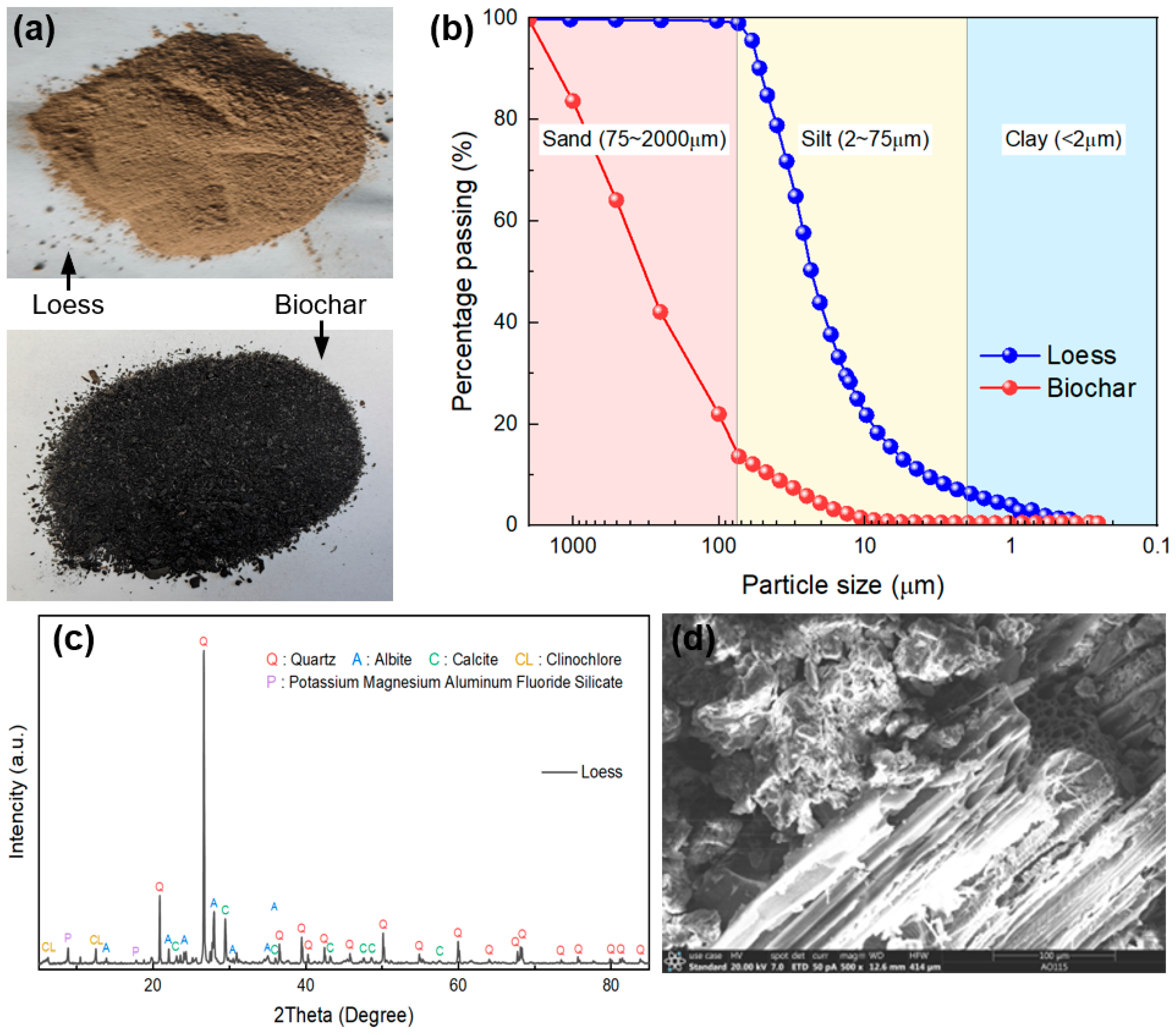
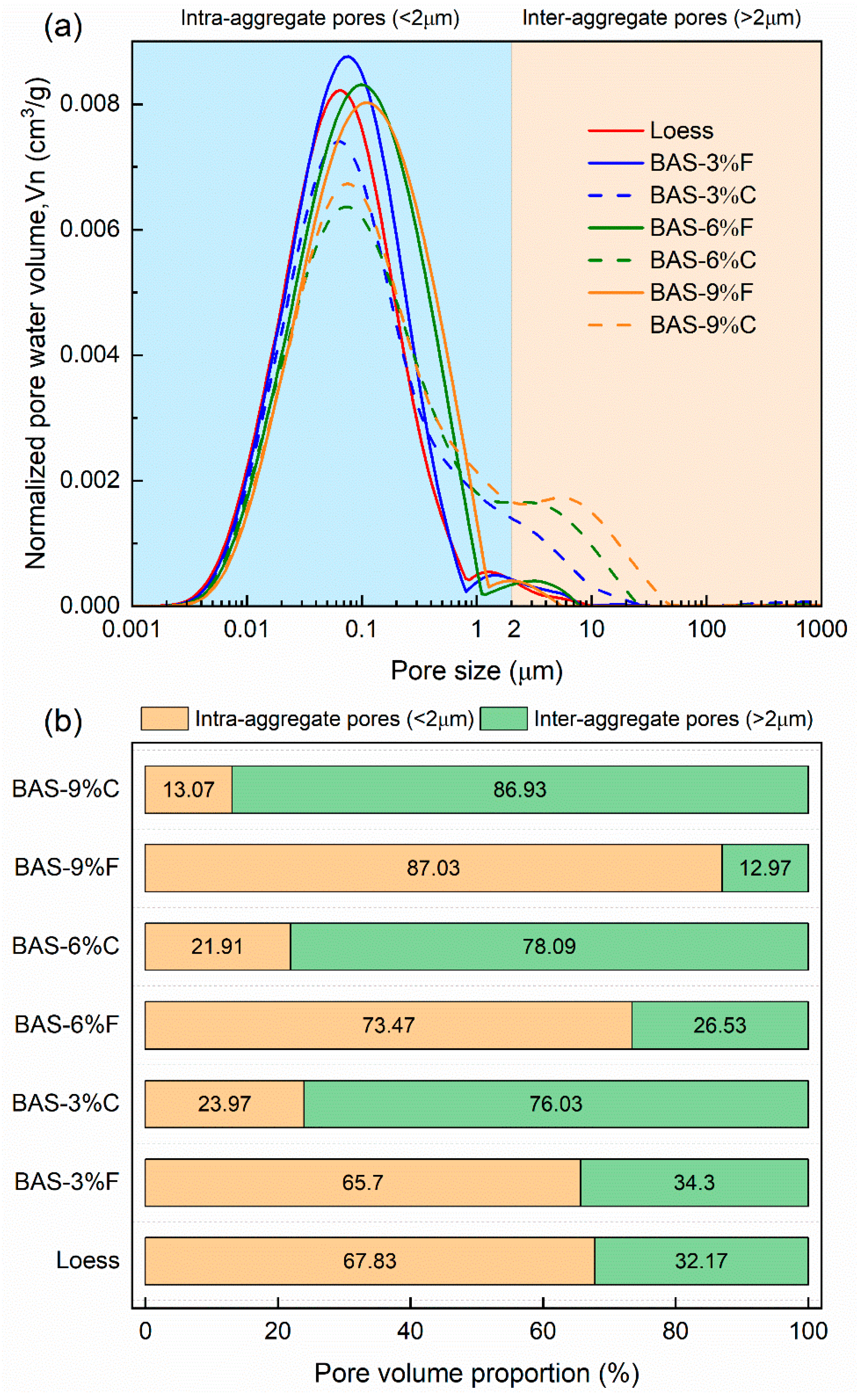
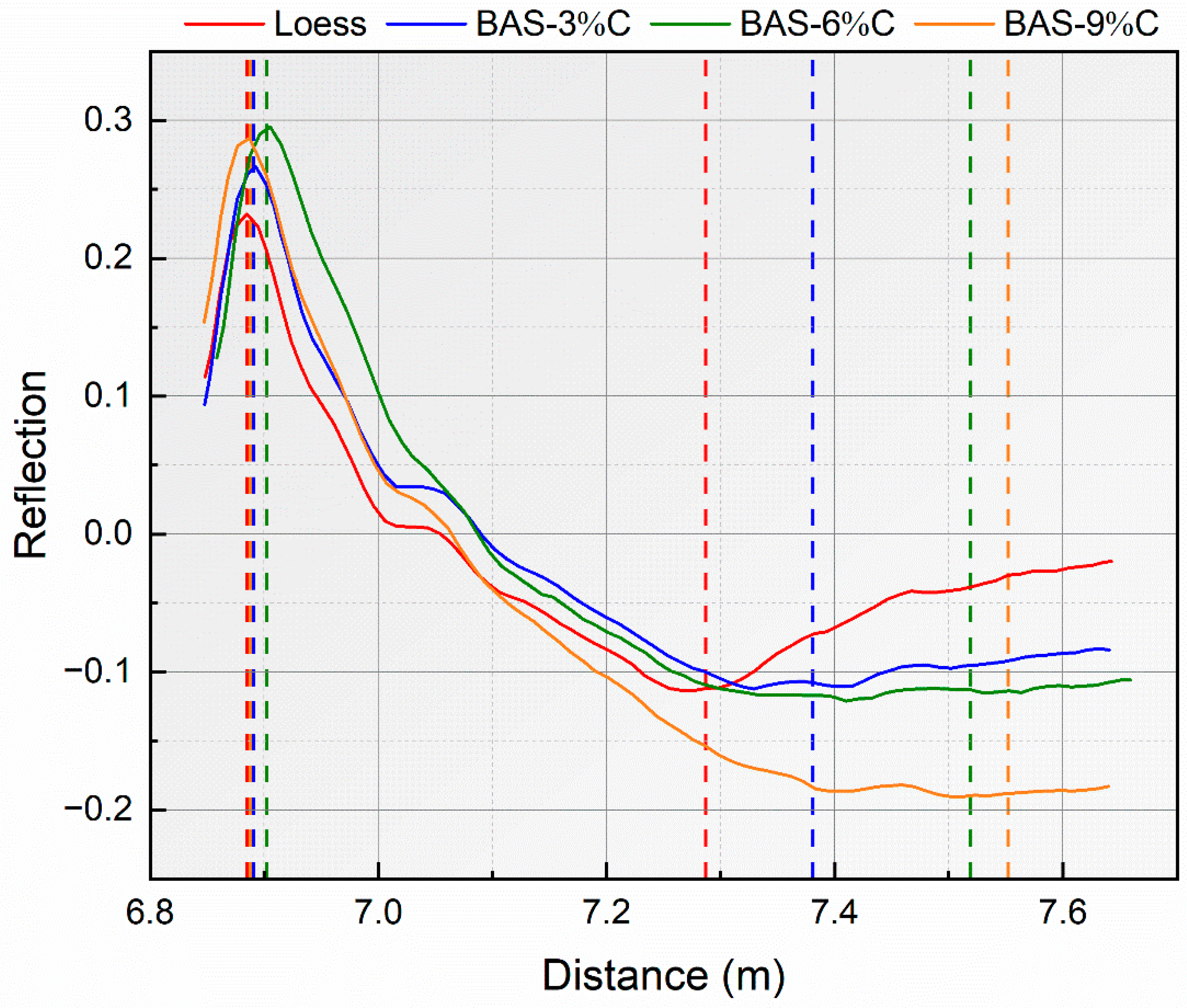

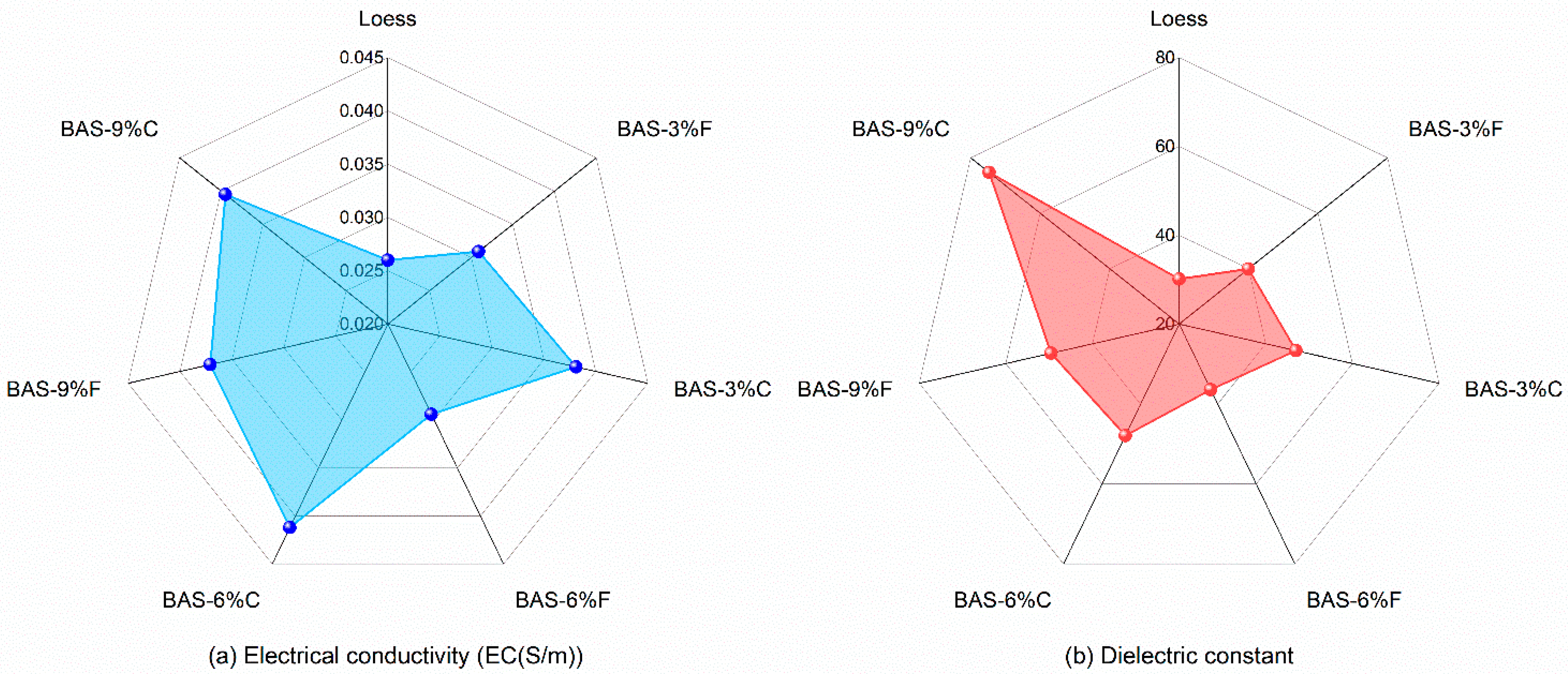
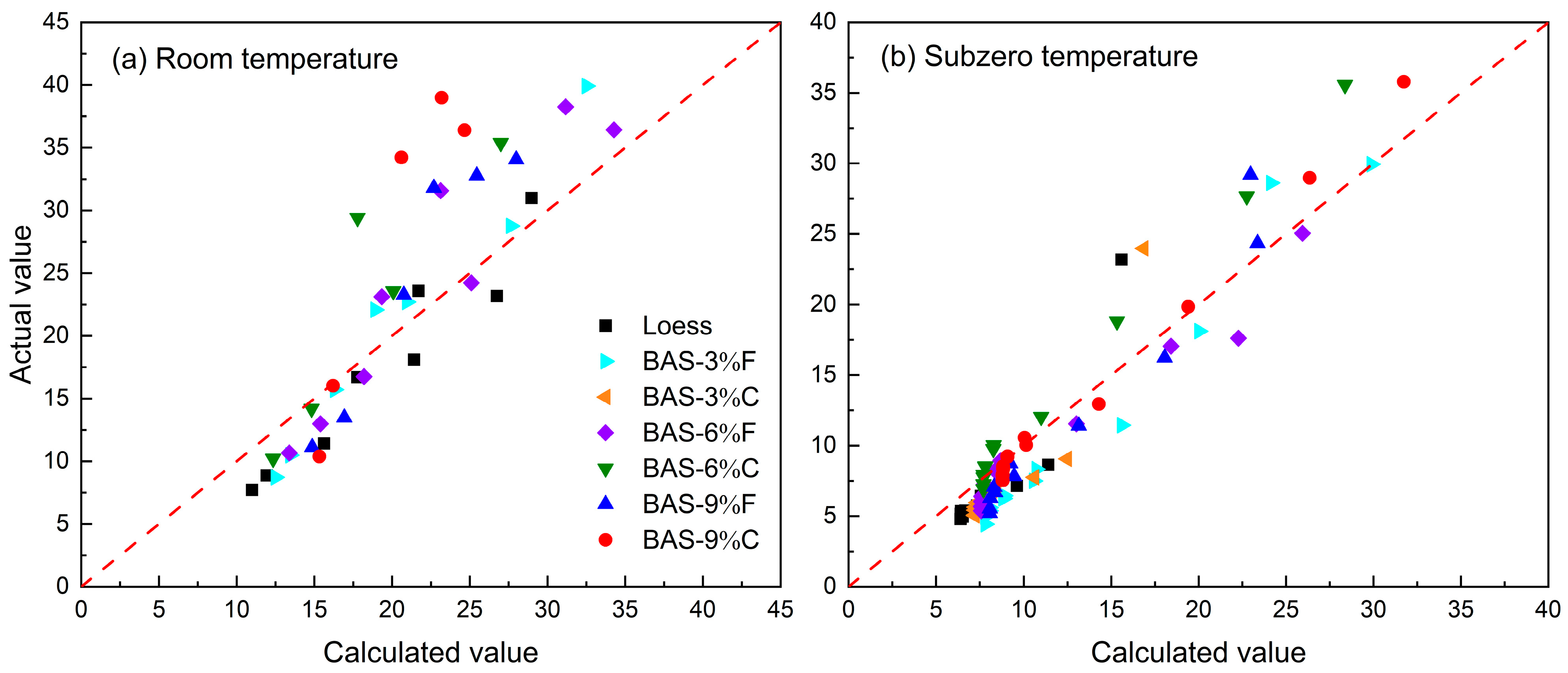
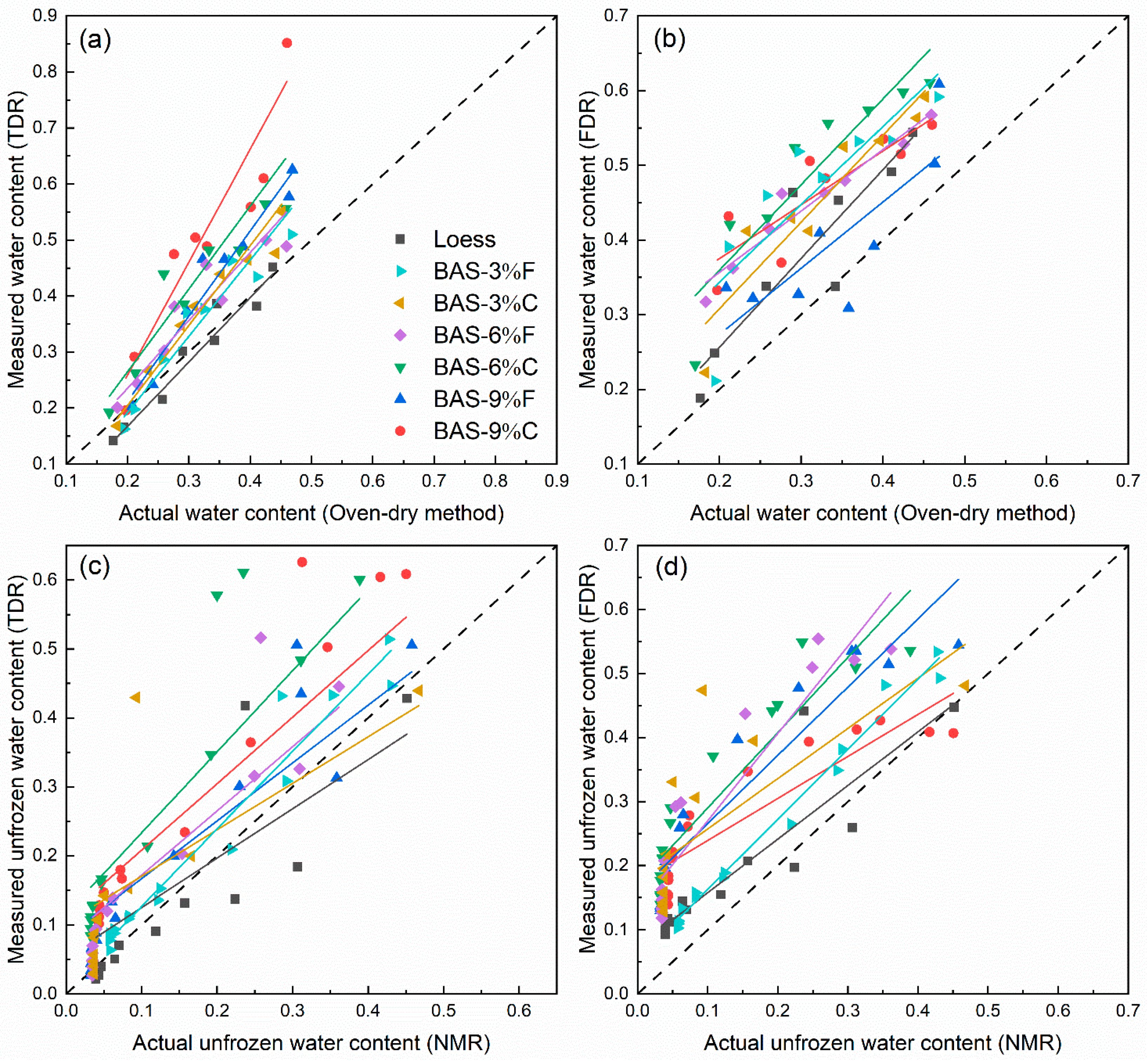
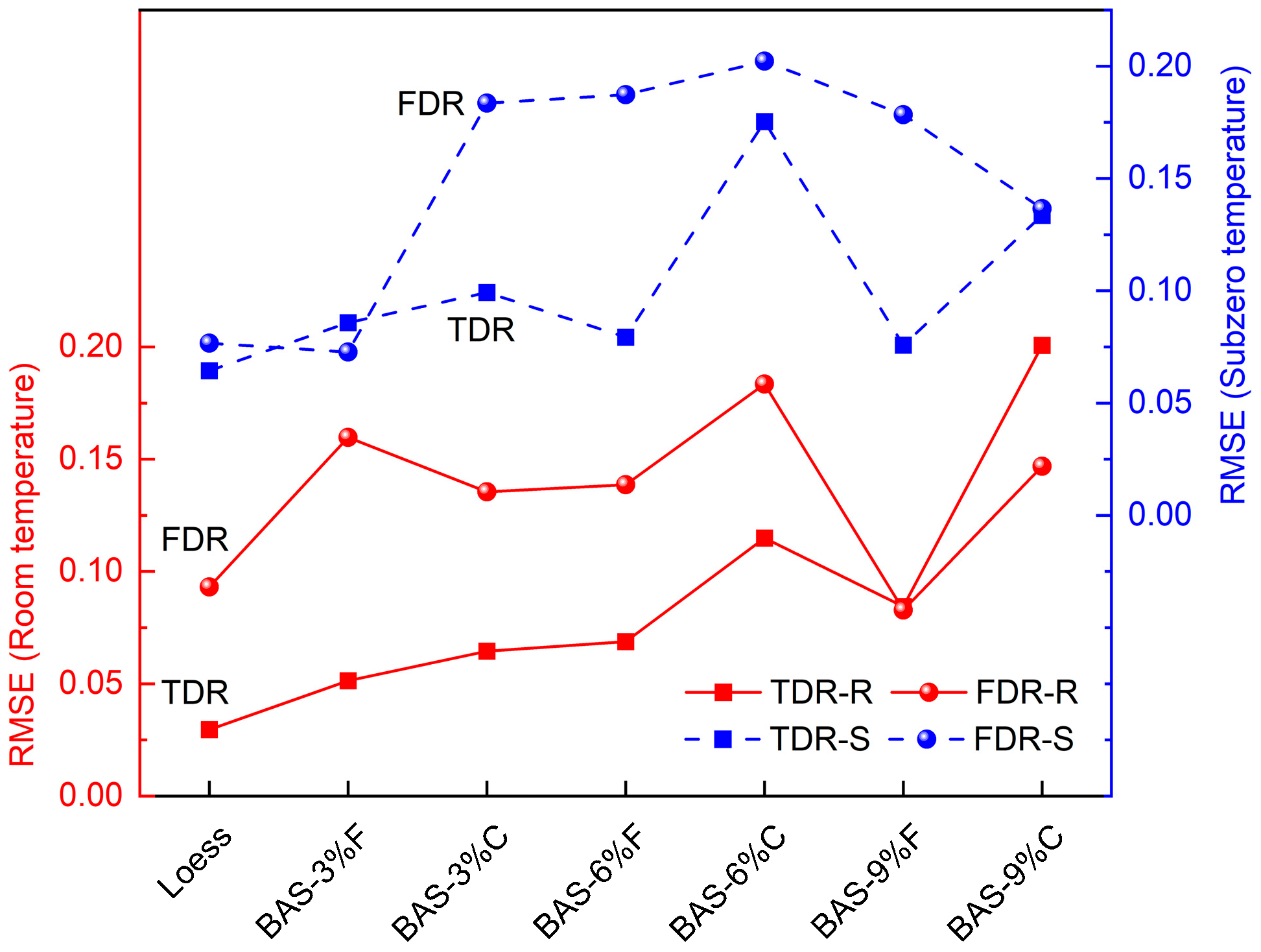


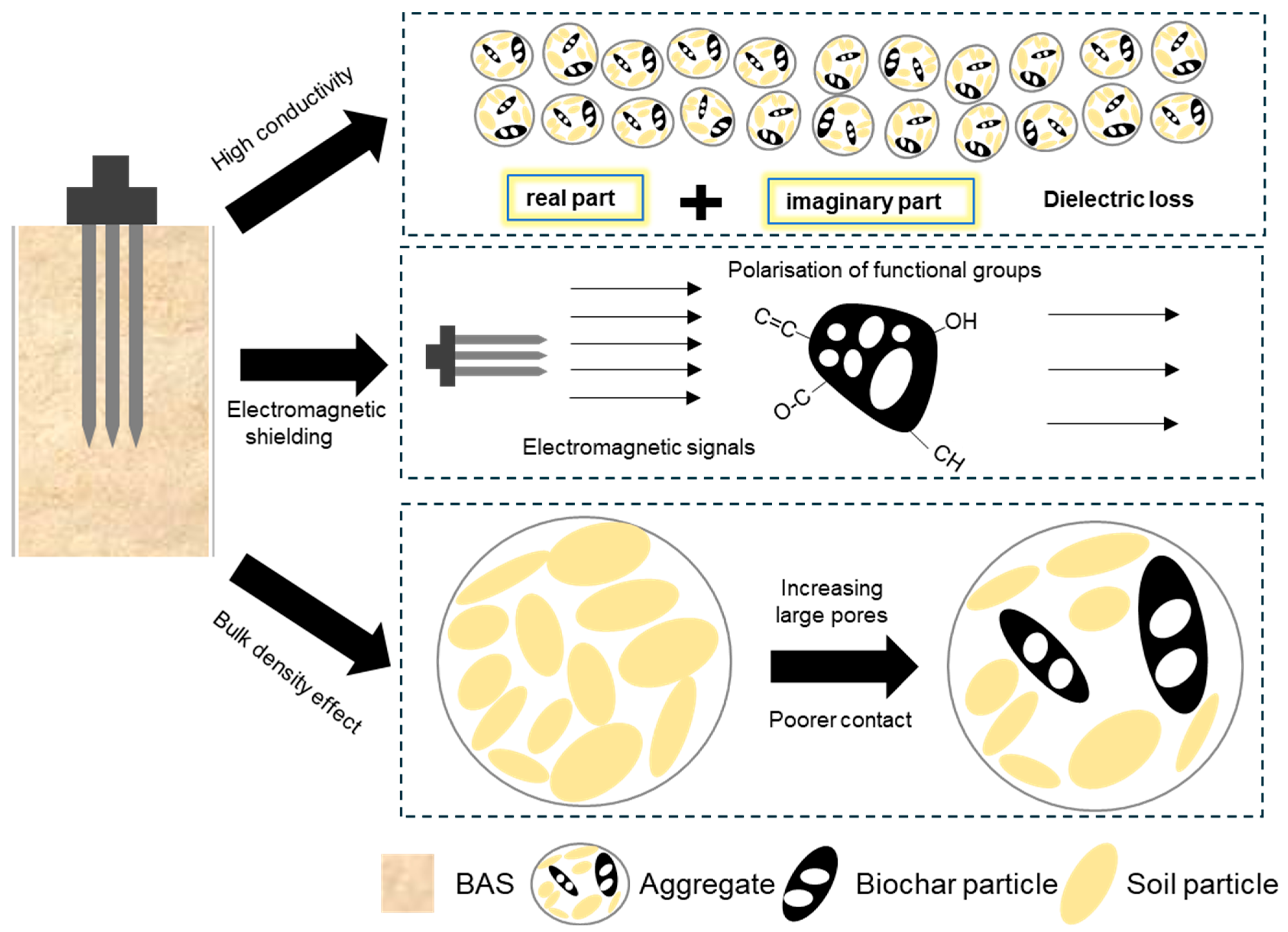
| Loess | Gs | LL (%) | PL (%) | PI (%) | OMC (%) | MDD (g/cm3) | USCS | pH | |
| 2.73 | 26.2 | 20.2 | 6.0 | 15.7 | 1.798 | Silty Clay | 7.80 | ||
| Biochar | Gs | Ash content (%) | pH | Surface ion content (mg/L) | |||||
| K+ | Ca2+ | Cl | SO42 | ||||||
| F | 1.84 | 41.33 | 8.81 | 28.45 | 0.45 | 11.49 | 2.19 | ||
| C | 1.58 | ||||||||
| TDR | Calibration Equation θv = a × (Ka)3 + b × (Ka)2 + c × Ka + d | |||||
|---|---|---|---|---|---|---|
| No. | a (×10−6) | b (×10−4) | c (×10−3) | d (×10−2) | R2 | |
| Room temperature | 1 | −1.56 | −0.432 | 8.21 | 11.45 | 0.88 |
| Subzero temperature | 2 | −8.16 | 5.52 | 1.64 | 1.37 | 0.96 |
| FDR | Calibration Equation θv = a × (RAW)3 + b × (RAW)2 + c × RAW + d | |||||
| No. | a (×10−10) | b (×10−6) | c (×10−2) | d | R2 | |
| Room temperature | 3 | −19.0 | 7.01 | −7.71 | 2.839 | 0.84 |
| Subzero temperature | 4 | −1.05 | 1.37 | −1.83 | 0.694 | 0.89 |
Disclaimer/Publisher’s Note: The statements, opinions and data contained in all publications are solely those of the individual author(s) and contributor(s) and not of MDPI and/or the editor(s). MDPI and/or the editor(s) disclaim responsibility for any injury to people or property resulting from any ideas, methods, instructions or products referred to in the content. |
© 2025 by the authors. Licensee MDPI, Basel, Switzerland. This article is an open access article distributed under the terms and conditions of the Creative Commons Attribution (CC BY) license (https://creativecommons.org/licenses/by/4.0/).
Share and Cite
Zhou, N.; Zhao, Z.; Li, M.; Ren, J.; Li, P.; Su, Q. Investigation into the Performance of TDR and FDR Techniques for Measuring the Water Content of Biochar-Amended Loess. Sensors 2025, 25, 3970. https://doi.org/10.3390/s25133970
Zhou N, Zhao Z, Li M, Ren J, Li P, Su Q. Investigation into the Performance of TDR and FDR Techniques for Measuring the Water Content of Biochar-Amended Loess. Sensors. 2025; 25(13):3970. https://doi.org/10.3390/s25133970
Chicago/Turabian StyleZhou, Nan, Ziyi Zhao, Ming Li, Junping Ren, Ping Li, and Qiang Su. 2025. "Investigation into the Performance of TDR and FDR Techniques for Measuring the Water Content of Biochar-Amended Loess" Sensors 25, no. 13: 3970. https://doi.org/10.3390/s25133970
APA StyleZhou, N., Zhao, Z., Li, M., Ren, J., Li, P., & Su, Q. (2025). Investigation into the Performance of TDR and FDR Techniques for Measuring the Water Content of Biochar-Amended Loess. Sensors, 25(13), 3970. https://doi.org/10.3390/s25133970





